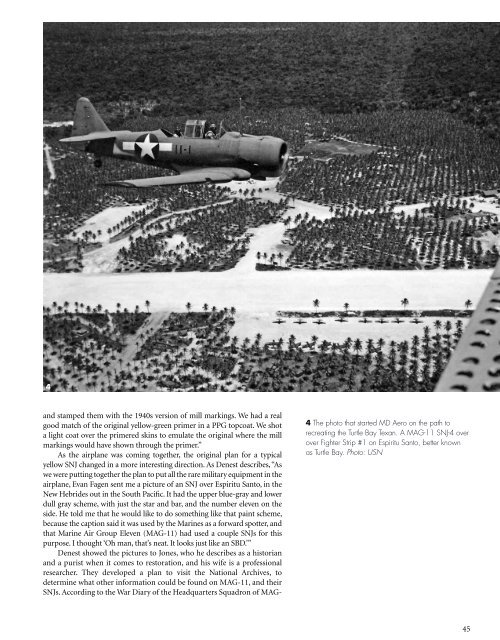WD74W2
You also want an ePaper? Increase the reach of your titles
YUMPU automatically turns print PDFs into web optimized ePapers that Google loves.
4<br />
and stamped them with the 1940s version of mill markings. We had a real<br />
good match of the original yellow-green primer in a PPG topcoat. We shot<br />
a light coat over the primered skins to emulate the original where the mill<br />
markings would have shown through the primer.”<br />
As the airplane was coming together, the original plan for a typical<br />
yellow SNJ changed in a more interesting direction. As Denest describes, “As<br />
we were putting together the plan to put all the rare military equipment in the<br />
airplane, Evan Fagen sent me a picture of an SNJ over Espiritu Santo, in the<br />
New Hebrides out in the South Pacific. It had the upper blue-gray and lower<br />
dull gray scheme, with just the star and bar, and the number eleven on the<br />
side. He told me that he would like to do something like that paint scheme,<br />
because the caption said it was used by the Marines as a forward spotter, and<br />
that Marine Air Group Eleven (MAG-11) had used a couple SNJs for this<br />
purpose. I thought ‘Oh man, that’s neat. It looks just like an SBD.’”<br />
Denest showed the pictures to Jones, who he describes as a historian<br />
and a purist when it comes to restoration, and his wife is a professional<br />
researcher. They developed a plan to visit the National Archives, to<br />
determine what other information could be found on MAG-11, and their<br />
SNJs. According to the War Diary of the Headquarters Squadron of MAG-<br />
4 The photo that started MD Aero on the path to<br />
recreating the Turtle Bay Texan. A MAG-11 SNJ-4 over<br />
over Fighter Strip #1 on Espiritu Santo, better known<br />
as Turtle Bay. Photo: USN<br />
45


